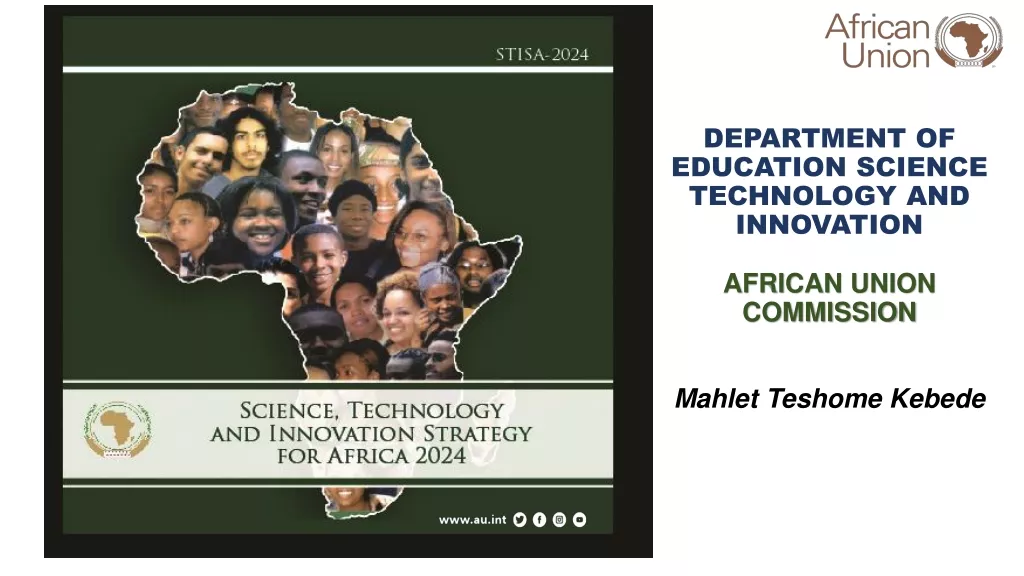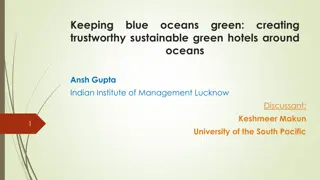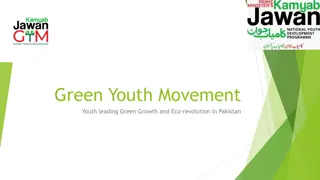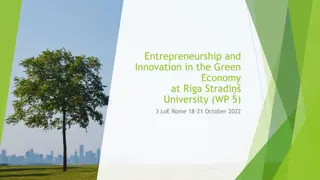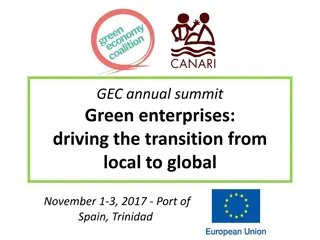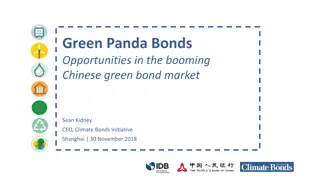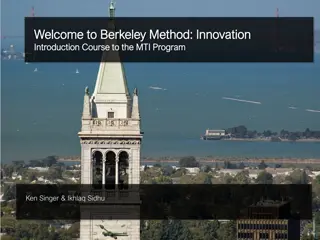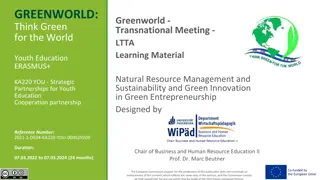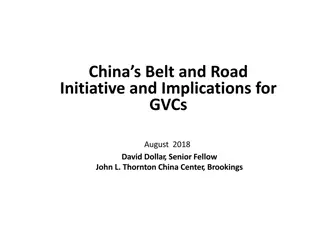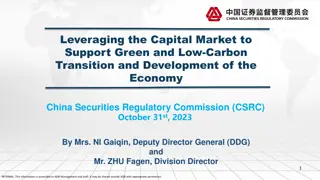The Importance of Spillovers for Green Technology Innovation in China
Reducing emissions from greenhouse gases in China requires the use of new technologies, often developed in high-income countries. This study examines the spillover gains from technology transfer in wind and solar energy sectors in China, highlighting the country's growing role in clean energy development and use.
Download Presentation

Please find below an Image/Link to download the presentation.
The content on the website is provided AS IS for your information and personal use only. It may not be sold, licensed, or shared on other websites without obtaining consent from the author.If you encounter any issues during the download, it is possible that the publisher has removed the file from their server.
You are allowed to download the files provided on this website for personal or commercial use, subject to the condition that they are used lawfully. All files are the property of their respective owners.
The content on the website is provided AS IS for your information and personal use only. It may not be sold, licensed, or shared on other websites without obtaining consent from the author.
E N D
Presentation Transcript
The importance of spillovers for green technology innovation: evidence from wind and solar in China David Popp The Maxwell School Syracuse University David Popp The Maxwell School of Citizenship and Public Affairs Syracuse University
Introduction Reducing emissions from greenhouse gases in China while still enabling continued economic growth requires the use of new technologies In most cases, these technologies are first created in high- income countries Thus, one challenge for climate policy is to encourage the transfer and continued development of these climate-friendly technologies in China I focus on two successful cases, looking at the potential spillover gains from technology transfer David Popp The Maxwell School of Citizenship and Public Affairs Syracuse University
Chinas growing role in clean energy China is beginning to emerge as a key player in both the development and use of clean energy Wind: Annual growth rates of installed capacity over 100% from 2003 to 2009 China became the worlds largest wind power country in terms of cumulative installed capacity in 2010 David Popp The Maxwell School of Citizenship and Public Affairs Syracuse University
Global Wind Capacity 70 60 China 50 United States Instaled Capacity, GW Germany Spain 40 India Italy 30 France United Kingdom 20 Canada 10 0 2005 2006 2007 2008 Year 2009 2010 2011 David Popp The Maxwell School of Citizenship and Public Affairs Syracuse University Source: Energy Information Administration International Energy Statistics
Chinas growing role in clean energy China is beginning to emerge as a key player in both the development and use of clean energy Wind: Annual growth rates of installed capacity over 100% from 2003 to 2009 China became the worlds largest wind power country in terms of cumulative installed capacity in 2010 Solar: China has become the world s leading producer of solar cells Unlike wind, solar industry focused on exports While exporting more than 95% of its production, China s share of global PV production rose from 1% in 2009 to 59% by 2010 David Popp The Maxwell School of Citizenship and Public Affairs Syracuse University
Global Solar Photovoltaic Installation and Chinese Firms Market Share, 2001-2012 Source: EPIA, 2013 David Popp The Maxwell School of Citizenship and Public Affairs Syracuse University
The Role of Technology Transfer What is technology transfer? A broad set of processes covering the flows of know-how, experience and equipment for mitigating and adapting to climate change amongst different stakeholders such as governments, private sector entities, financial institutions, non-governmental organizations (NGOs) and research/education institutions . (IPCC 2007) David Popp The Maxwell School of Citizenship and Public Affairs Syracuse University
Why is Technology Transfer Important? Nearly all of the world s R&D is performed in the developed OECD economies China is a notable exception David Popp The Maxwell School of Citizenship and Public Affairs Syracuse University
2011 Global R&D Expenditures ROW US China other OECD Japan Italy Canada Germany UK Russia France S. Korea David Popp The Maxwell School of Citizenship and Public Affairs Syracuse University
Why is Technology Transfer Important? Nearly all of the world s R&D is performed in the developed OECD economies True for green innovation as well Dechezlepr tre et al. (2011) find that 2/3 of climate-friendly innovations from 1978-2003 come from the U.S., Japan, or Germany => In many cases, technologies needed to promote green growth will already be available Thus, transferring clean technologies to emerging economies is the key issue Can result in both direct use (adoption) and increased capacity to develop and innovate David Popp The Maxwell School of Citizenship and Public Affairs Syracuse University
Technology Transfer & Spillovers Benefits to the recipient developing country depend on the type of transfer: Embodied technology transfer comes through the importation of equipment into a country (e.g., flows of equipment) May make a country more productive, but doesn t give the recipient the ability to replicate Disembodied technology transfer involves the flow of know-how or experience Examples include demonstration projects, training local staff, and local firms hiring away staff from multinational firms operating in a developing country May enhance the productivity of future projects in the country A concern to source firms, as lead to knowledge spillovers David Popp The Maxwell School of Citizenship and Public Affairs Syracuse University
Technology Transfer & Spillovers Knowledge spillovers occur when a new technology enhances the capacity of others to innovate without providing direct compensation to the inventor Enable the recipient to develop skills that can be used in later projects initiated by the recipient country Can increase domestic capacity to produce, use, and innovate David Popp The Maxwell School of Citizenship and Public Affairs Syracuse University
Long run effects of spillovers Long-term effects of $1 million aid increase Change in NRHE generation (TWh) Kim (2014) David Popp The Maxwell School of Citizenship and Public Affairs Syracuse University
Two cases I present two examples of successful spillovers in clean energy 1. Learning from Clean Development Mechanism (CDM) wind project partnerships (Tang & Popp, 2014) 2. PV innovation from intellectual returnees (Luo, Lovely, & Popp 2013) David Popp The Maxwell School of Citizenship and Public Affairs Syracuse University
Case #1: The Learning Process and Technological Change in Wind Power: Evidence from China s CDM Wind Projects Tian Tang and David Popp, 2014 NBER Working Paper #19921 David Popp The Maxwell School of Citizenship and Public Affairs Syracuse University
Motivation: CDM and Chinas Wind Industry CDM: A project-basedcarbon transaction mechanism under the Kyoto Protocol that allows developed countries with emission constraints to purchase emission credits by financing projects that reduce carbon emissions in developing countries. Goals of CDM: - Help developing countries reduce carbon emissions - Stimulate sustainable development in developing countries through technology transfer from developed countries The Role of CDM in China s Wind Industry - China has actively engaged in CDM since 2002 and used it to provide financial support for over 80% of wind projects David Popp The Maxwell School of Citizenship and Public Affairs Syracuse University
Major sellers in project-based transactions CDM Pipeline, October 2012 David Popp The Maxwell School of Citizenship and Public Affairs Syracuse University
Distribution of technologies in project-based transactions over time State and Trends of the Carbon Market, 2012 David Popp The Maxwell School of Citizenship and Public Affairs Syracuse University
Motivation: CDM and Chinas Wind Industry Can CDM Help Developing Countries Achieve Sustainable Development? Depends on whether technology transfers are embodied or disembodied Disembodied transfers not only reduce emissions now, but lower the costs of future emission reductions In contrast, embodied transfers (e.g. providing equipment) pick low-hanging fruit and make it harder for developing countries to do more later This makes these countries less likely to participate in future treaties! David Popp The Maxwell School of Citizenship and Public Affairs Syracuse University
Low-Hanging Fruit and Knowledge Spillovers Popp (2010) David Popp The Maxwell School of Citizenship and Public Affairs Syracuse University
Motivation: CDM and Chinas Wind Industry Chinese policy promoted technology transfer Chinese guidelines for CDM project approval state that CDM project activities should promote the transfer of environmentally sound technology to China. Domestic content requirement: 70% of wind turbine content must be produced domestically David Popp The Maxwell School of Citizenship and Public Affairs Syracuse University
Theory: Learning Process and Technological Change Following technological learning and collaboration theories, we identify the following channels of learning that could lead to the reduction of electricity production cost: David Popp The Maxwell School of Citizenship and Public Affairs Syracuse University
Data and Empirical Model Unit of Analysis: CDM wind power project Data - Pooled cross-sectional - 510 registered CDM wind projects in China that started from 2002 to 2009 (486 obs after excluding missing data) - Including 87 developers and 23 turbine manufacturers Sources: 1) Validated CDM project design document and its attached financial analysis spreadsheet for each project 2) Yearbook from Chinese Wind Energy Association 3) Delphion patent database David Popp The Maxwell School of Citizenship and Public Affairs Syracuse University
Data and Empirical Model Dependent Variables: 1) Projected unit cost of electricity production of project i started construction in year t (levelized cost) ????????+ ?&?? (? + ?)? ?=? ? ???????????? (? + ?)? ?=? ? (????_????)??= / 2) Projected unit capital cost of project i started in year t ? ????????+ ?&?? (? + ?)? ???????????? (? + ?)? ?=? ? (????_????)??= / ?=? 3) Projected capacity factor of project i started in year t ?????????????????? ?????/??? ??????? ??????????? (??)??= David Popp The Maxwell School of Citizenship and Public Affairs Syracuse University
Data and Empirical Model Explanatory Variables: Learning Effects David Popp The Maxwell School of Citizenship and Public Affairs Syracuse University
Results 1. Learning by searching - Wind projects benefit from the knowledge stock of their turbine manufacturers - The effect is small though David Popp The Maxwell School of Citizenship and Public Affairs Syracuse University
Effects of collaborating experience and technology transfer (1) (2) (3) (4) (5) Dependent Variables ln(unit cost) ln(unit cost) ln(unit capital cost) ln(unit capital cost) ln(capacity factor) Knowledge stock of manufacturer Manufacturer s experience alone (GW) Developer s experience in CDM projects alone (GW) Cooperating experience in CDM (GW) Turbine size (MW) -0.00029** (0.00013) -0.00211 (0.00572) -0.02333*** (0.00658) -0.04149** (0.01874) 0.01068 (0.01481) -0.34063*** (0.12296) -0.14092*** (0.02805) -0.09387*** (0.02688) -0.01251 (0.01974) 0.03097* (0.01607) -0.01624 (0.01126) 0.03259* (0.01885) -0.00025* (0.00013) -0.00216 (0.00571) -0.02230*** (0.00655) -0.03971** (0.01876) 0.00929 (0.01493) -0.33709*** (0.12246) -0.14541*** (0.02850) -0.09348*** (0.02706) -0.01419 (0.01983) 0.03969** (0.01751) -0.01554 (0.01128) 0.03183* (0.01890) -0.13107** (0.06000) Yes Yes 486 0.687 -0.00031* (0.00018) -0.00768 (0.00704) -0.03393*** (0.00800) -0.05406** (0.02299) 0.03342* (0.01817) -0.34582*** (0.13293) -0.21581*** (0.02739) -0.16919*** (0.02500) -0.02476 (0.01851) 0.03535* (0.01951) -0.00684 (0.01453) 0.05485** (0.02443) -0.00027 (0.00017) -0.00772 (0.00703) -0.03304*** (0.00798) -0.05252** (0.02314) 0.03221* (0.01825) -0.34276** (0.13291) -0.21969*** (0.02766) -0.16885*** (0.02479) -0.02621 (0.01852) 0.04288** (0.02138) -0.00624 (0.01453) 0.05419** (0.02451) -0.11329 (0.08382) Yes Yes 486 0.608 0.00032** (0.00013) 0.00409 (0.00561) 0.01073* (0.00573) 0.00648 (0.01987) 0.05609*** (0.01113) 0.13304** (0.07367) 0.13652*** (0.03066) 0.09923*** (0.03028) -0.00723 (0.01576) 0.00442 (0.01530) 0.00514 (0.01040) -0.02825 (0.01902) Project size (GW) Wind category 1 Wind category 2 Wind category 3 Foreign manufacturer Central SOE developer Local SOE developer Foreign manufacturer* cooperating experience Province fixed effects Year fixed effects Observations R-squared Yes Yes 486 0.685 Yes Yes 486 0.607 Yes Yes 486 0.606 Robust standard errors in parentheses, *** p<0.01, ** p<0.05, * p<0.1
Results 1. Learning by searching 2. Learning by doing - Wind projects benefit from developer s internal experience in both wind farm installation and operation David Popp The Maxwell School of Citizenship and Public Affairs Syracuse University
Effects of collaborating experience and technology transfer (1) (2) (3) (4) (5) Dependent Variables ln(unit cost) ln(unit cost) ln(unit capital cost) ln(unit capital cost) ln(capacity factor) Knowledge stock of manufacturer Manufacturer s experience alone (GW) Developer s experience in CDM projects alone (GW) Cooperating experience in CDM (GW) Turbine size (MW) -0.00029** (0.00013) -0.00211 (0.00572) -0.02333*** (0.00658) -0.04149** (0.01874) 0.01068 (0.01481) -0.34063*** (0.12296) -0.14092*** (0.02805) -0.09387*** (0.02688) -0.01251 (0.01974) 0.03097* (0.01607) -0.01624 (0.01126) 0.03259* (0.01885) -0.00025* (0.00013) -0.00216 (0.00571) -0.02230*** (0.00655) -0.03971** (0.01876) 0.00929 (0.01493) -0.33709*** (0.12246) -0.14541*** (0.02850) -0.09348*** (0.02706) -0.01419 (0.01983) 0.03969** (0.01751) -0.01554 (0.01128) 0.03183* (0.01890) -0.13107** (0.06000) Yes Yes 486 0.687 -0.00031* (0.00018) -0.00768 (0.00704) -0.03393*** (0.00800) -0.05406** (0.02299) 0.03342* (0.01817) -0.34582*** (0.13293) -0.21581*** (0.02739) -0.16919*** (0.02500) -0.02476 (0.01851) 0.03535* (0.01951) -0.00684 (0.01453) 0.05485** (0.02443) -0.00027 (0.00017) -0.00772 (0.00703) -0.03304*** (0.00798) -0.05252** (0.02314) 0.03221* (0.01825) -0.34276** (0.13291) -0.21969*** (0.02766) -0.16885*** (0.02479) -0.02621 (0.01852) 0.04288** (0.02138) -0.00624 (0.01453) 0.05419** (0.02451) -0.11329 (0.08382) Yes Yes 486 0.608 0.00032** (0.00013) 0.00409 (0.00561) 0.01073* (0.00573) 0.00648 (0.01987) 0.05609*** (0.01113) 0.13304** (0.07367) 0.13652*** (0.03066) 0.09923*** (0.03028) -0.00723 (0.01576) 0.00442 (0.01530) 0.00514 (0.01040) -0.02825 (0.01902) v Project size (GW) A typical CDM project by the same developer leads to about a 0.13% decrease in future unit costs Wind category 1 Wind category 2 Wind category 3 Foreign manufacturer Central SOE developer Local SOE developer Foreign manufacturer* cooperating experience Province fixed effects Year fixed effects Observations R-squared Yes Yes 486 0.685 Yes Yes 486 0.607 Yes Yes 486 0.606 Robust standard errors in parentheses, *** p<0.01, ** p<0.05, * p<0.1
Results 1. Learning by searching 2. Learning by doing 3. Cost reduction through repeated collaboration - Repeated partnerships between project developers and manufacturer lead to even lower electricity production costs, particularly for capital costs - However, cooperating experience does not significantly improve capacity factor David Popp The Maxwell School of Citizenship and Public Affairs Syracuse University
Effects of collaborating experience and technology transfer (1) (2) (3) (4) (5) Dependent Variables ln(unit cost) ln(unit cost) ln(unit capital cost) ln(unit capital cost) ln(capacity factor) Knowledge stock of manufacturer Manufacturer s experience alone (GW) Developer s experience in CDM projects alone (GW) Cooperating experience in CDM (GW) Turbine size (MW) -0.00029** (0.00013) -0.00211 (0.00572) -0.02333*** (0.00658) -0.04149** (0.01874) 0.01068 (0.01481) -0.34063*** (0.12296) -0.14092*** (0.02805) -0.09387*** (0.02688) -0.01251 (0.01974) 0.03097* (0.01607) -0.01624 (0.01126) 0.03259* (0.01885) -0.00025* (0.00013) -0.00216 (0.00571) -0.02230*** (0.00655) -0.03971** (0.01876) 0.00929 (0.01493) -0.33709*** (0.12246) -0.14541*** (0.02850) -0.09348*** (0.02706) -0.01419 (0.01983) 0.03969** (0.01751) -0.01554 (0.01128) 0.03183* (0.01890) -0.13107** (0.06000) Yes Yes 486 0.687 -0.00031* (0.00018) -0.00768 (0.00704) -0.03393*** (0.00800) -0.05406** (0.02299) 0.03342* (0.01817) -0.34582*** (0.13293) -0.21581*** (0.02739) -0.16919*** (0.02500) -0.02476 (0.01851) 0.03535* (0.01951) -0.00684 (0.01453) 0.05485** (0.02443) -0.00027 (0.00017) -0.00772 (0.00703) -0.03304*** (0.00798) -0.05252** (0.02314) 0.03221* (0.01825) -0.34276** (0.13291) -0.21969*** (0.02766) -0.16885*** (0.02479) -0.02621 (0.01852) 0.04288** (0.02138) -0.00624 (0.01453) 0.05419** (0.02451) -0.11329 (0.08382) Yes Yes 486 0.608 0.00032** (0.00013) 0.00409 (0.00561) 0.01073* (0.00573) 0.00648 (0.01987) 0.05609*** (0.01113) 0.13304** (0.07367) 0.13652*** (0.03066) 0.09923*** (0.03028) -0.00723 (0.01576) 0.00442 (0.01530) 0.00514 (0.01040) -0.02825 (0.01902) Project size (GW) Wind category 1 A typical CDM project by the same developer/ manufacturer team leads to around a 0.23% to 0.25% decrease in future unit costs Wind category 2 Wind category 3 Foreign manufacturer Central SOE developer Local SOE developer Foreign manufacturer* cooperating experience Province fixed effects Year fixed effects Observations R-squared Yes Yes 486 0.685 Yes Yes 486 0.607 Yes Yes 486 0.606 Robust standard errors in parentheses, *** p<0.01, ** p<0.05, * p<0.1
Results 1. Learning by searching 2. Learning by doing 3. Cost reduction through repeated collaboration 4. Technology transfer through CDM - The Learning-by-interacting effect is largest when a wind project developer repeatedly collaborates with a foreign manufacturer David Popp The Maxwell School of Citizenship and Public Affairs Syracuse University
Effects of collaborating experience and technology transfer (1) (2) (3) (4) (5) Dependent Variables ln(unit cost) ln(unit cost) ln(unit capital cost) ln(unit capital cost) ln(capacity factor) Knowledge stock of manufacturer Manufacturer s experience alone (GW) Developer s experience in CDM projects alone (GW) Cooperating experience in CDM (GW) Turbine size (MW) -0.00029** (0.00013) -0.00211 (0.00572) -0.02333*** (0.00658) -0.04149** (0.01874) 0.01068 (0.01481) -0.34063*** (0.12296) -0.14092*** (0.02805) -0.09387*** (0.02688) -0.01251 (0.01974) 0.03097* (0.01607) -0.01624 (0.01126) 0.03259* (0.01885) -0.00025* (0.00013) -0.00216 (0.00571) -0.02230*** (0.00655) -0.03971** (0.01876) 0.00929 (0.01493) -0.33709*** (0.12246) -0.14541*** (0.02850) -0.09348*** (0.02706) -0.01419 (0.01983) 0.03969** (0.01751) -0.01554 (0.01128) 0.03183* (0.01890) -0.13107** (0.06000) Yes Yes 486 0.687 -0.00031* (0.00018) -0.00768 (0.00704) -0.03393*** (0.00800) -0.05406** (0.02299) 0.03342* (0.01817) -0.34582*** (0.13293) -0.21581*** (0.02739) -0.16919*** (0.02500) -0.02476 (0.01851) 0.03535* (0.01951) -0.00684 (0.01453) 0.05485** (0.02443) -0.00027 (0.00017) -0.00772 (0.00703) -0.03304*** (0.00798) -0.05252** (0.02314) 0.03221* (0.01825) -0.34276** (0.13291) -0.21969*** (0.02766) -0.16885*** (0.02479) -0.02621 (0.01852) 0.04288** (0.02138) -0.00624 (0.01453) 0.05419** (0.02451) -0.11329 (0.08382) Yes Yes 486 0.608 0.00032** (0.00013) 0.00409 (0.00561) 0.01073* (0.00573) 0.00648 (0.01987) 0.05609*** (0.01113) 0.13304** (0.07367) 0.13652*** (0.03066) 0.09923*** (0.03028) -0.00723 (0.01576) 0.00442 (0.01530) 0.00514 (0.01040) -0.02825 (0.01902) One more CDM wind project that a developer builds together with the same foreign manufacturer will reduce the unit cost by almost 1%: 4 times of the effects of collaborating with domestic manufacturer Project size (GW) Wind category 1 Wind category 2 Wind category 3 Foreign manufacturer Central SOE developer Local SOE developer Foreign manufacturer* cooperating experience Province fixed effects Year fixed effects Observations R-squared Yes Yes 486 0.685 Yes Yes 486 0.607 Yes Yes 486 0.606 Robust standard errors in parentheses, *** p<0.01, ** p<0.05, * p<0.1
Case #2: Intellectual Returnees as Drivers of Indigenous Innovation: Evidence from the Chinese Photovoltaic Industry Siping Luo, Mary Lovely, and David Popp, 2013 NBER Working Paper #19518 David Popp The Maxwell School of Citizenship and Public Affairs Syracuse University
Solar PV in China As noted earlier, China has become a leading producer of solar PV de la Tour et al. (2011) identify the importance of international technology transfer as the driver of China s success Particularly in more advanced production segments and for continuing adaptive innovation in downstream segments, they highlight the importance of skills and indigenous adaptation as key the sector s development David Popp The Maxwell School of Citizenship and Public Affairs Syracuse University
Solar PV in China During this development process, intellectual returnees played a crucial role Pioneers in the industry are the well known three returnees of China s photovoltaic industry: Huaijin Yang, Zhengrong Shi, and Jianhua Zhao All three studied photovoltaic technology in Australia in the 1990s, and then returned to China with advanced technology and foreign capital to start firms using China s relatively low-wage skilled labor force The importance of returnees to the industry is a central finding from field interviews carried out by Luo and Yu (2012) and by de la Tour et al. (2011) This paper extends this field work to a broader sample of Chinese PV firms David Popp The Maxwell School of Citizenship and Public Affairs Syracuse University
PV Patenting in China While most R&D and patenting occurs in developed countries, China is an exception Both overall and in renewable energy, patenting in China has increased rapidly Key questions: What about quality? What forces support innovation in the PV sector? David Popp The Maxwell School of Citizenship and Public Affairs Syracuse University
Chinas share of PV patents is growing de la Tour et al., Energy Policy (2011) David Popp The Maxwell School of Citizenship and Public Affairs Syracuse University
Data Firm-level operation data of Chinese PV 1998 to 2008, 806 firms in total; 1851 firm-year observation Source: Annual Survey of Industrial Firms of China Firm s patents application records 3508 patents in total through 2011, 290 firms have at least one patent Source: Delphion Firm leaders international experience 151 firms leader( or other executives) have international experience Source: Author s collection from company websites & other Internet sources David Popp The Maxwell School of Citizenship and Public Affairs Syracuse University
Patent Quality Detailed scrutiny of the 3508 patent records suggests that much of this innovative activity represents incremental innovation Most are process innovations, rather than new products 2/3 are utility or design innovations Utility patents protect minor improvements to existing technology for only 10 years This is consistent with the need for adaptive R&D for technology transfer A key adaptation was using more labor to produce PV cells, to take advantage of lower labor costs in China David Popp The Maxwell School of Citizenship and Public Affairs Syracuse University
Model Patenti,t = f(IntlExper_Leaderit, IntlExper_Execit, ln(IntlExper_Clusterit), ln(IndustryClusteri,t), ln(UnivDisti,t), Xi,t, yeart) The Cluster variables test for spillovers Sums international experience of all other firms, placing more weight on those closest: ??,? ??,? . ?????????_?????????= ? ? David Popp The Maxwell School of Citizenship and Public Affairs Syracuse University
Results Both the international experience of a firm s leader and its executive board lead to large increases in patenting Increases by a factor of 4 or more! David Popp The Maxwell School of Citizenship and Public Affairs Syracuse University
Dependent Variable Total Patent Count [1] Negative Binomial FE 1.384*** 0.436 0.894** 0.407 0.198 0.236 -0.044 0.11 -0.016 0.166 0.426*** 0.157 -0.162** 0.064 0.049 0.131 0.058 0.153 -337.48 445 [2] Estimator Poisson FE 3.792*** 0.374 1.649*** 0.402 0.876** 0.375 0.289* 0.164 - - -0.357** 0.166 0.079 0.087 0.056 0.239 0.382 0.246 -503.61 445 IntlExper_Leaderit IntlExper_Execit Ln(IntlExper_Clusterit) Ln(IndustryClusteri,t) Ln(UnivDisti,t) Ln(MarketPoweri,t) Ln(Exporti,t) Ln(Agei,t) Ln(Sizei,t) Log-Likelihood Number of Observations Standard errors in parentheses. * p<0.10, ** p<0.05, *** p<0.01
Results Both the international experience of a firm s leader and its executive board lead to large increases in patenting Increases by a factor of 4 or more! There are spillovers from international experience David Popp The Maxwell School of Citizenship and Public Affairs Syracuse University
Dependent Variable Total Patent Count [1] Negative Binomial FE 1.384*** 0.436 0.894** 0.407 0.198 0.236 -0.044 0.11 -0.016 0.166 0.426*** 0.157 -0.162** 0.064 0.049 0.131 0.058 0.153 -337.48 445 [2] Estimator Poisson FE 3.792*** 0.374 1.649*** 0.402 0.876** 0.375 0.289* 0.164 - - -0.357** 0.166 0.079 0.087 0.056 0.239 0.382 0.246 -503.61 445 IntlExper_Leaderit IntlExper_Execit Ln(IntlExper_Clusterit) Ln(IndustryClusteri,t) Ln(UnivDisti,t) Ln(MarketPoweri,t) Ln(Exporti,t) Ln(Agei,t) Ln(Sizei,t) Log-Likelihood Number of Observations Standard errors in parentheses. * p<0.10, ** p<0.05, *** p<0.01
Results Both the international experience of a firm s leader and its executive board lead to large increases in patenting Increases by a factor of 4 or more! There are spillovers from international experience Even conditional on R&D, international experience leads to more patents May make R&D more productive May better appreciate need for IP protection David Popp The Maxwell School of Citizenship and Public Affairs Syracuse University
Dependent Variables Total Patent Count, 2005-2007 [1] [2] [3] Estimator Poisson FE Poisson RE Poisson RE Using the same sample as [1] -0.356 0.415 1.374*** 0.375 -0.030 0.188 0.397*** 0.084 -0.087 0.116 -0.630*** 0.123 -0.082 0.056 0.082 0.125 0.295** 0.135 0.011 0.020 -326.05 155 Using full sample (2005-2007) Samples - 14.92*** 1.320 16.46*** 1.746 -0.720 0.916 0.473** 0.191 - - -0.902*** 0.276 -0.058 0.147 0.397* 0.222 0.385 0.319 0.012 0.070 -155.20 155 0.528 0.656 2.239*** 0.501 0.005 0.209 0.380*** 0.090 -0.151 0.140 -0.772*** 0.125 -0.008 0.058 0.119 0.112 0.444*** 0.149 0.057*** 0.022 -468.33 705 IntlExper_Leaderit IntlExper_Execit Ln(IntlExper_Clusterit) Ln(IndustryClusteri,t) Ln(UnivDisti,t) Ln(MarketPoweri,t) Ln(Exporti,t) Ln(Agei,t) Ln(Sizei,t) Ln(RDi,t) Log-Likelihood Number of observations
Summary Sources of learning Wind Collaboration important Wind project developers in China learn from partnerships with foreign firms However, little evidence of spillovers in the wind case Solar Bringing foreign experience home leads to more innovation Benefits do spillover to neighboring firms David Popp The Maxwell School of Citizenship and Public Affairs Syracuse University
Key questions Moving forward, identifying limits to spillovers is important What is different about the wind and solar cases? Collaborative learning may be tacit knowledge that is difficult to transfer What makes spillovers possible in the solar case? Can other countries follow China s lead? Policies attracting technology transfer must balance encouraging spillovers with discouraging investors Will policies promoting spillovers discourage multinational investment in smaller countries? David Popp The Maxwell School of Citizenship and Public Affairs Syracuse University
Policy Implications For Chinese policymakers: - Provides support for policies encouraging return of those studying abroad - Collaboration important. Targeted policies to forge partnerships between foreign and domestic players appear valuable For international climate change policy: - Results shed light on how CDM facilitates technology transfer by encouraging cooperation between local project developers and foreign turbine manufacturers - Success of Chinese solar industry has been controversial - To what extent has this success lowered the cost of solar and reduced global emissions? David Popp The Maxwell School of Citizenship and Public Affairs Syracuse University



